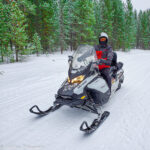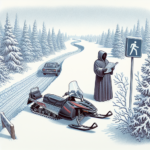Revving up a snowmobile and gliding across a winter landscape can be an exhilarating experience. However, it’s crucial to remember that these vehicles can be treacherous if not operated with due diligence and caution. In the article “Why Are Snowmobiles Dangerous?”, the focus is on the inherent risks involved in snowmobiling. From high speeds on unpredictable terrain to the potential for severe accidents and even the risk of avalanches, the potential for danger is significant. Understanding these risks and learning safety precautions will equip you with the knowledge to make your snowmobile adventure as safe as possible.
Risk of High Speeds
You’re out in the snow, ripping through the fresh powder at high speeds, feeling the adrenaline pumping. It seems fun, thrilling even. However, what you might overlook are the risks associated with the high speeds on a snowmobile.
Impaired judgement and control
When you’re blazing down a trail at high speed, your ability to think quickly and make sound judgments can become impaired due to the thrill and focus on maintaining controlover your snowmobile. This could lead to overlooking small elements that might pose significant risks.
Increased chance of collision
The faster you ride your snowmobile, the harder it becomes to react swiftly and safely to prevent colliding with obstacles or other riders. This is because as the speed increases, the reaction time decreases, hence increasing the chance of collision.
Difficulty stopping or slowing down quickly
When you’re going at high speeds, your ability to slow down or stop becomes compromised. This is particularly dangerous when unexpected obstacles or turns arise, causing you to lose control and potentially leading to a crash.
Operating in Extreme Cold
Operating a snowmobile in extreme cold can present a variety of challenges, requiring proper equipment and mental preparation.
Risk of hypothermia
On a snowmobile, you’re exposed to extreme cold, increasing your risk of developing hypothermia. If not addressed immediately, hypothermia can lead to severe health problems, including death.
Visibility challenges due to snow and fog
Snow and fog can impair visibility, making it difficult to clearly see the path ahead. This can lead to misjudging distances, failing to notice obstacles, or even getting lost.
Difficulty in maneuvering snowmobile
Extreme cold can also result in difficulty in maneuvering the snowmobile. Snow and ice may affect the traction of the vehicle, making it harder to control and increasing the risk of tipping over or crashing.
Lack of Protective Structure
The lack of a protective structure in a snowmobile can enhance its recreational appeal by offering a sense of freedom and interaction with the environment. However, it also poses risks for both operators and riders.
Exposed operator and riders
Without a protective structure, operators and riders are exposed to environmental hazards. For instance, a fallen tree branch or rock could directly hit a rider, resulting in injuries.
Greater risk of injury in case of a crash
In case of a crash, the lack of protective structure can result in greater injury to the operator and riders. Without the safety provided by features such as seat belts and airbags, the risk of being thrown off and sustaining significant injury increases.
Absence of seat belts
The lack of seatbelts in snowmobiles further increases the risk of injuries during a crash. A seatbelt can prevent you from being thrown out of the vehicle during an impact, reducing the risk of severe harm.
Potential for Avalanches
Riding in mountainous, snowy terrain can present risks like avalanches, which are both challenging to predict and to escape.
Snowmobiles can trigger avalanches
The vibration and noise caused by snowmobiles can potentially trigger an avalanche, especially if the snow is unsettled or unstable.
Potential lack of escape routes
In case an avalanche is triggered, finding an escape route could be difficult, especially given the speed at which an avalanche travels. The terrain might also be challenging to navigate quickly enough to evade the avalanche.
Insufficient equipment for Avalanche survival
Surviving an avalanche often requires specialized equipment and training, which may not be readily available to every snowmobiler. Essential survival equipment includes items like beacon devices, avalanche airbags, and probes.
Lack of avalanche training
Without proper training on how to react and survive during an avalanche, even the presence of appropriate equipment might not be enough to save a snowmobiler’s life.
Navigating challenging and unpredictable terrain is part of what makes snowmobiling an adventure. However, the very unpredictability that adds thrill to the adventure makes it dangerous as well.
Risk of falling into crevasses
Crevasses disguised under a light dusting of snow pose a severe risk for snowmobilers. Falling into one could lead to severe injuries or being trapped without a possible way to escape.
Unexpected obstacles under snow
Besides crevasses, terrain covered with snow might also hide other obstacles, such as rocks, fallen trees, or stumps. Colliding with these obstacles could result in severe accidents.
Risk of falling off cliffs or slopes
Open cliffs or steep slopes that are not clearly visible due to snow or poor lighting can be quite dangerous. There’s a risk of falling off, which could potentially result in severe traumas, paralysis, or even death.
Exhaustion and Dehydration
Even though snowmobiling might appear to be a relaxed activity, it can be physically demanding and could lead to exhaustion and dehydration if not properly managed.
Extended period in extreme weather conditions
Spending extended periods in extreme cold can put a significant strain on your body, leading to exhaustion or even conditions like frostbite or hypothermia.
Physical exertion while operating snowmobile
Operating a snowmobile requires physical effort, contributing to quicker exhaustion. The effects could be intensified due to the cold as your body works harder to maintain core temperature.
Decreased performance
Dehydration and exhaustion can lead to decreased physical performance, slower reaction times and impaired judgment, all of which can increase the risk of accidents.
Inappropriate or Insufficient Gear
While all machines need maintenance and decent gear, it’s especially important when it comes to snowmobiles. The difference between having the right gear or not can be a matter of life and death.
Lack of helmets or safety vests
Failure to wear a helmet increases the risk of head injuries in the case of an accident. Similarly, not wearing a safety vest could result in more severe injuries thrown from the snowmobile.
Poor quality or ill-fitted protective outfits
Protective outfitting needs to be of good quality and properly fitted. Poor fitting can result in impaired movement and reduced control over the snowmobile.
Deficiency of communication devices
When riding in remote areas, having reliable communication devices is vital. In case of emergencies, being unable to call for help could have dire consequences.
Adventurous but Risky Behaviors
Snowmobiling is a thrilling activity, no doubt. However, some behaviors may increase the risk of accidents and injuries.
High jumping and stunts
While pulling off stunts and high jumps may seem like fun, they can significantly increase the risk of accidents and severe injury.
Off-trail riding
Off-trail riding can be adventurous, but it also poses an increased risk due to unpredictable terrain and the potential for getting lost.
Night riding without proper lighting
Riding at night without adequate lighting is extremely risky as it reduces visibility, making it hard to see obstacles or dangerous terrain ahead.
Riding on frozen bodies of water
Riding on frozen lakes or rivers could be dangerous if the ice is not thick enough to support the snowmobile’s weight. A break in the ice could lead to drowning or severe hypothermia.
Lack of Training and Expertise
Operating a snowmobile requires certain skills and knowledge for safe riding. Lack of training and expertise can significantly increase the risk of accidents.
Incompetency in operating snowmobile
Without the right skills to operate a snowmobile, you’re likely to make mistakes that can lead to accidents, potentially hurting yourself and others.
Unawareness of safety procedures
Not knowing the safety measures to take while operating a snowmobile can be hazardous. For example, you should always maintain a safe distance from other snowmobilers and always keep to the trail.
Inadequate knowledge of local terrain and weather conditions
Operating a snowmobile without a thorough understanding of the local terrain and weather can expose you to unnecessary risks like avalanches and unexpected obstacles.
Mechanical Failures
Mechanical failures when operating a snowmobile can present serious hazards, particularly in remote or dangerous terrain.
Breakdowns in isolated locations
Often, snowmobiling takes place in isolated areas, far from immediate assistance. If a mechanical failure happens, you may be left stranded in the cold, posing a significant risk to your well-being.
Fires due to mechanical issues
Though rare, mechanical failures can cause fires in snowmobiles. This could lead to severe injuries, particularly if the rider is not wearing proper protective clothing.
Compromised control due to equipment failure
A malfunction in steering or braking equipment can compromise control, making it difficult to avoid obstacles or safely navigate the terrain. This significantly increases the risk of accidents and injuries.
In closing, it’s apparent that snowmobiling, while a thrilling and enjoyable activity, carries with it several risks. Awareness of these threats and knowledge of how to mitigate them can go a long way in ensuring a safe and fun snowmobiling experience.
- What Snowboard Bindings Should I Get? - January 23, 2024
- What Size Screws For Snowboard Bindings? - January 23, 2024
- How To Snowmobile On Water? - January 23, 2024










